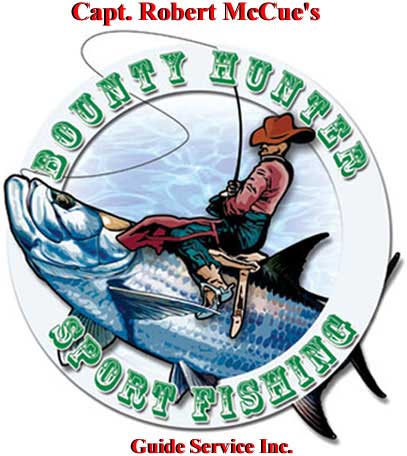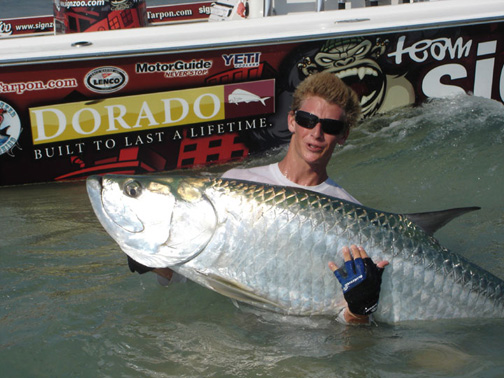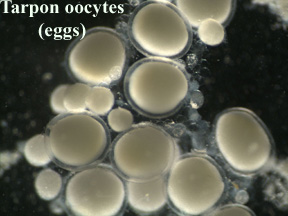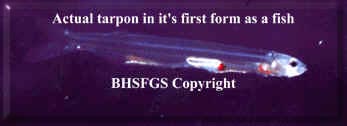

This Florida tarpon fishing mini series uncovers the tarpon fishing secrets of Florida tarpon guide, Capt. Robert McCue and the tarpon fishing techniques actually employed on his tarpon fishing charters. The series discusses tarpon biology, saltwater flats and backcountry tarpon fishing, flyfishing, light tackle fishing, jig fishing tarpon in Boca Grande, and tarpon fishing in the Tampa Bay, St. Petersburg, Bradenton, Sarasota, Port Charlotte, Clearwater, Orlando and Disney area of Florida. Whether you are tarpon fishing guru, or have ever dreamed of catching a Giant Florida tarpon, the series offers something for everyone. In part one, lets meet the Megalops Atlanticus...THE SILVER KING.
Introduction
| Tarpon
Fishing Part II | Tarpon Fishing
Part III | Tarpon Fishing Part IV
|
![]()
 As I laid the boat off plane in the predawn darkness, a light east breeze whispered across the calm Florida water. Slowly drifting and waiting for the first morning light, a low frequency buzz that only a tarpon guide can detect radiates from the bow. The client's anticipation builds with the rising sun and the buzz becomes a vibration. The angler's heartbeat can be felt on the bottom of my feet. The kings surface for a gulp of air, and I position the boat. The angler's knees rattle. This is the moment he dreamed of, a chance of a lifetime, the opportunity to test his mettle against the silver gladiator, the beast of all beasts, the Megalops atlanticus, a.k.a. the Tarpon.
As I laid the boat off plane in the predawn darkness, a light east breeze whispered across the calm Florida water. Slowly drifting and waiting for the first morning light, a low frequency buzz that only a tarpon guide can detect radiates from the bow. The client's anticipation builds with the rising sun and the buzz becomes a vibration. The angler's heartbeat can be felt on the bottom of my feet. The kings surface for a gulp of air, and I position the boat. The angler's knees rattle. This is the moment he dreamed of, a chance of a lifetime, the opportunity to test his mettle against the silver gladiator, the beast of all beasts, the Megalops atlanticus, a.k.a. the Tarpon.
And so it goes, another morning at the office for those who pursue the silver king for a living along the Gulf Coast of Florida. It's my favorite time of the year that starts in spring and for a few in the know, lasts until the first cold fronts of winter.
Sabalo are the most non-discriminate big game catches in the world due to their habitat of close proximity to the shoreline. They are caught by fishermen from all walks of life and social stature. They can be taken from piers, docks, roadsides, causeways, bridges, bays, rivers, beaches, passes and jetties. They are fished from kayaks, canoes, rowboats, jon boats and jet skis to $50,000 skiffs and million dollar yachts. They are tackled on everything from Zebco Rhinos to $1500 fly rods and everything in between. While by the nature of tarpon habits, physique and temperament-they may not be for everyone who likes to go catching. However, they are the pinnacle in the hunt for big game and for those with the passion for the sport of fishing. Giant tarpon are the ultimate aquatic safari and championship of fishing equivalent to Super Bowl, the World Series, the Daytona 500, Tour de France and the World Cup.
 Let's begin this introduction to tarpon fishing with the first tip I give all anglers in pursuit of any gamefish anywhere in the world: Get to know the species you are after. So exactly what do we know about the Megalops atlanticus? Well, actually not much. Research of the tarpon fish has been minimal compared to some other species of fish. This is because tarpon have no food value. Most of the tarpon research has been funded by private funds and via the state's revenue generated by the sale of Florida tarpon tags. Recently and in recognition of the economical impact of tarpon to Florida, the Florida Fish and Wildlife Commission has allocated funds to the Florida Marine Research Institute to study tarpon statewide over a five year period.
Let's begin this introduction to tarpon fishing with the first tip I give all anglers in pursuit of any gamefish anywhere in the world: Get to know the species you are after. So exactly what do we know about the Megalops atlanticus? Well, actually not much. Research of the tarpon fish has been minimal compared to some other species of fish. This is because tarpon have no food value. Most of the tarpon research has been funded by private funds and via the state's revenue generated by the sale of Florida tarpon tags. Recently and in recognition of the economical impact of tarpon to Florida, the Florida Fish and Wildlife Commission has allocated funds to the Florida Marine Research Institute to study tarpon statewide over a five year period.
We know tarpon are prehistoric animals, traveling the warm seas back as far as 100 million years ago. They are one of the few fish known to us as possessing an swim bladder. This unique organ is attached to the esophagus and acts much like a lung allowing them to actually breath from the atmosphere. They obtain this air by "rolling" on the surface and taking a gulp. Tarpon use this exclusive feature to survive in fresh water and oxygen-depleted, stagnant waters. The swim bladder plays a key roll in the survival in juvenile tarpon life. Juvenile tarpon are dependant on breathing air from the atmosphere as it permits them to exist and mature in places where only they can survive, thus preventing their natural enemies (sharks in particular) from reaching them. The swim bladder is a gift to tarpon anglers from the fish gods. Tarpon rolling makes finding and fishing Florida tarpon a wee bit easier.
Shortly after the first moon in spring, adult tarpon begin to show up along our coast. Some speculate tarpon migrate north from the Keys. I too believe some fish do make this migration. However, I theorize they also migrate from the continental shelf 125 miles offshore, where they winter in the warm waters of the Gulf Loop due west, or perhaps they cross southwest from the Yucatan.
During this early spring show, tarpon most often enter the large bays of Tampa and Charlotte Harbor, and the first grass flats inside major passes. These waters are most often a few degrees warmer than the still chilly gulf and supply the food source for these hungry fish. The migration continues all through April, May and June all along our beaches, passes and flats. This migration to the shoreline is related to some sort of pre-spawn ritual.
 Tarpon often display a courtship in which they "mill" or "daisy chain." On close inspection I have seen the fish bumping and rubbing up against each other, though scientist maintain that the fish are not actually spawning during this display of affection. Often they are very much preoccupied in the act of foreplay and can be very temperamental, particularly around the major moon phases. During these moon phases many of these tarpon break off and head offshore to spawn near the continental shelf. I believe they make the journey quickly, all the while more tarpon are moving in. The spawned-out tarpon will return inshore a few days later after completing their business. Tarpon are true lunar fish. Besides snook, their behavior and movements during these periods are that of no other fish I target. By the full moon in June the early tarpon that entered the bays will have left to join the legions of tarpon on the beaches and flats. Offshore, an unfertilized female drops a "batch" of eggs (oocytes) that are fertilized by he male's "milt" of sperm and shortly later become larvae. The larvae take on the appearance of a ribbon or an eel. One mature female may spawn as many as 15 million undeveloped tarpon.The mortality of these larvae is very high, as they are at the mercy of the sea (they become the food source of zooplankton and fish).
Tarpon often display a courtship in which they "mill" or "daisy chain." On close inspection I have seen the fish bumping and rubbing up against each other, though scientist maintain that the fish are not actually spawning during this display of affection. Often they are very much preoccupied in the act of foreplay and can be very temperamental, particularly around the major moon phases. During these moon phases many of these tarpon break off and head offshore to spawn near the continental shelf. I believe they make the journey quickly, all the while more tarpon are moving in. The spawned-out tarpon will return inshore a few days later after completing their business. Tarpon are true lunar fish. Besides snook, their behavior and movements during these periods are that of no other fish I target. By the full moon in June the early tarpon that entered the bays will have left to join the legions of tarpon on the beaches and flats. Offshore, an unfertilized female drops a "batch" of eggs (oocytes) that are fertilized by he male's "milt" of sperm and shortly later become larvae. The larvae take on the appearance of a ribbon or an eel. One mature female may spawn as many as 15 million undeveloped tarpon.The mortality of these larvae is very high, as they are at the mercy of the sea (they become the food source of zooplankton and fish).
These larvae are great swimmers and with the help of the winds and tides make a great journey a 125 miles to the estuaries (if they are lucky), where they will once again undergo three distinct changes from a transparent ribbon like eel to the form of a fish that can easily be recognized as a micro tarpon. I once thought that spawning activity was highest around the full moon. Recent research shows that, the dark moon may actually be more active. Ironically, this theory would further testament to natural tarpon survival---they use the cover of a dark sky to protect their eggs from predators.
 These micro Florida tarpon find protection in the estuaries' mangroves and non-tidal pools, where they engage in a period of rapid growth. In this early stage of fish form, they find and live in ditches and retention ponds. Many of these areas appear to be landlocked and may be many miles from the gulf. The water is very low in oxygen, and their unique swim bladder allows them a safe haven from predators who would not even consider tasting this stagnant soup. To actually find these tarpon nurseries, you cant help but wonder how they can live there, how they got there and how will they ever get out.
These micro Florida tarpon find protection in the estuaries' mangroves and non-tidal pools, where they engage in a period of rapid growth. In this early stage of fish form, they find and live in ditches and retention ponds. Many of these areas appear to be landlocked and may be many miles from the gulf. The water is very low in oxygen, and their unique swim bladder allows them a safe haven from predators who would not even consider tasting this stagnant soup. To actually find these tarpon nurseries, you cant help but wonder how they can live there, how they got there and how will they ever get out.
 Tarpon are survivors. In fact the Megalops atlanticus, some scientist believe, are one of two ( Megalops cyprinoides, ox-eye tarpon-found primarily in the Indo Pacific) of the last living family members of many other species of tarpon that existed millions of years ago. As these tarpon grow to about two feet, they move once again, to a larger body of water. They are fond of deep, man-made canals and holes far up Florida coastal rivers, and in the upper reaches of large bays. When they reach sexual maturity at the age of 7-13 years of age, they join in with the adult Gulf tarpon. Male tarpon attain life spans of over 30 years, while females may live longer than 50 years. A female tarpon held in captivity at the John G. Shedd Aquarium in Chicago, Illinois died in 1998 at the age of 63.
Tarpon are survivors. In fact the Megalops atlanticus, some scientist believe, are one of two ( Megalops cyprinoides, ox-eye tarpon-found primarily in the Indo Pacific) of the last living family members of many other species of tarpon that existed millions of years ago. As these tarpon grow to about two feet, they move once again, to a larger body of water. They are fond of deep, man-made canals and holes far up Florida coastal rivers, and in the upper reaches of large bays. When they reach sexual maturity at the age of 7-13 years of age, they join in with the adult Gulf tarpon. Male tarpon attain life spans of over 30 years, while females may live longer than 50 years. A female tarpon held in captivity at the John G. Shedd Aquarium in Chicago, Illinois died in 1998 at the age of 63.
These "baby" tarpon have always fascinated me. Over the years I've caught tarpon as small as 2.5 inches long in small tidal ponds while throwing a cast net for chubs. I've found them ( 10 to 20 inches) in retention ponds connected to the Cotee (2 miles away) River via a drain pipe. And I found them in the rivers and canals ranging from 10 to 60 pounds. The best tip I can give for these special little gems is....keep your eyes open. Baby tarpon could be found just about anywhere.
 I once had a spot that I wrongly shared with another guide who was having a tough day. After swearing on his life, I took him into the hole. Some 30 tarpon ranging from 20 to 50 pounds went in the air that day between us. Typical for the honey hole...at least for me. Very shortly there after, the spot became famous. Soon every "Captain" Tom, Dick, and Harry was in there trying to gain a name for themselves. To add further insult to injury, they brought the media writers, and film crews...the rest folks is history, easy come-easy go. From this and many other similar experiences, it is my opinion that the genetic instinct of a survival of an animal 100 million years old---they are masters at changing their patterns in avoiding over fishing.
I once had a spot that I wrongly shared with another guide who was having a tough day. After swearing on his life, I took him into the hole. Some 30 tarpon ranging from 20 to 50 pounds went in the air that day between us. Typical for the honey hole...at least for me. Very shortly there after, the spot became famous. Soon every "Captain" Tom, Dick, and Harry was in there trying to gain a name for themselves. To add further insult to injury, they brought the media writers, and film crews...the rest folks is history, easy come-easy go. From this and many other similar experiences, it is my opinion that the genetic instinct of a survival of an animal 100 million years old---they are masters at changing their patterns in avoiding over fishing.
The adult spawn may actually take place through July (and perhaps later), but most fish have spawned by the end of June and I believe these fish begin a northward migration both offshore and inshore along the beaches. This late north migration theory has gotten me much talk, but for anyone who truly does a lot of tarpon fishing...you know what I am saying is true. These fish are most often hungry, particularly if they are "greenbacks" - those just returning from the offshore spawn. "Greenbacks" have great appetites after going through the rigorous act of spawning, and the exhausting 125 mile journey back to shore. We will pass up dark back tarpon for the greenback tarpon when the situation arises on our fishing charters. These fish are here to forage and found close to a food source.
 Many of these northbound tarpon will "break off" their travel path and enter the bays, harbors and rivers where they will stay until the first series of cold fronts. In theory, others continue on their path to other places such as Apalachicola, Louisiana, Alabama and Texas. In Florida, the remaining fish offer a spectacular "post season" fishery until the cold fronts push the tarpon south and offshore to the Gulf Loop, and perhaps back to the Yucatan. Only to start the cycle all over again next spring.
Many of these northbound tarpon will "break off" their travel path and enter the bays, harbors and rivers where they will stay until the first series of cold fronts. In theory, others continue on their path to other places such as Apalachicola, Louisiana, Alabama and Texas. In Florida, the remaining fish offer a spectacular "post season" fishery until the cold fronts push the tarpon south and offshore to the Gulf Loop, and perhaps back to the Yucatan. Only to start the cycle all over again next spring.
Back in yesteryear it was common for guides and anglers to hang tarpon from "brag boards" for photo opportunities and to feed their ego. Such images in this modern era are subject of much ridicule. The conservation minded sport fishing community finds these acts unacceptable and repulsive in the 21st century as the fish have no value dead (however biologist do try to gain possession of these harvested fish for research-a far better idea than a dumpster). In 1989, the state enacted a $50 kill tag and imposed a two fish harvest limit per day. Florida reported tarpon kills went from 342 in 1989 to 70 in 1998. In the present day-tarpon populations are strong statewide. However, natural and manmade variables such as red tide, water temperatures, salinity, pollution, habitat destruction (development), sharks and angling pressure have kept fishery managers vigil and they are monitoring the health of the fishery now with the world renown Florida Marine Research Institute (in conjunction with tarpon anglers). As well, the private sector of scientist are expanding their research into such areas as genetic profiling, satellite tracking and ultrasonic telemetry. To view the tracking map of a tagged 160lb. tarpon caught from my boat in 2004, click here.
| Tarpon Fishing Part
II | Tarpon
Fishing Part III | Tarpon Fishing Part IV |
We invite you to surf our entire site by following the links
below. We welcome your e-mail or you may call
Capt. Robert McCue's
Bounty Hunter Florida Sport
Fishing Charters & Guide Service
toll free for
booking information.
Year 2024 Florida Tarpon fishing schedule
![]() Send
E-Mail
To Capt.RobertMcCue@Gmail.com
Send
E-Mail
To Capt.RobertMcCue@Gmail.com
Call or Text
(727) 597-0957 ( Cell ) or (941) 404-3399
| Home | All About Tarpon Fishing | Snook | Flyfishing | Florida Fishing Report | Tarpon Guarantee |
| About The Area | Species We Catch | 200 lb. Giant Tarpon Club | Our Location | Video |
| Frequently Asked Questions | Moons and Weather | | 2024 Giant Tarpon Fishing Schedule |
| In The News | How & Why To Follow Us on Social Media |
This site contains tons of World Class Gamefish images. Please view the entire site to view these images.
![]()
New March 15, 2004
Copyright 1986-2024 Capt. Robert McCue
All Rights Reserved. Do not reproduce or distribute in any form.